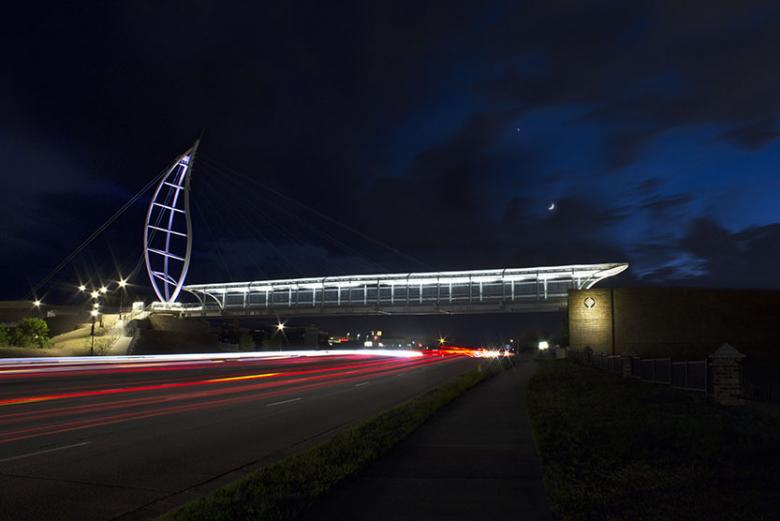Fentress Architects
Lone Tree Pedestrian Bridge
Fentress Architects
2. julho 2018
Photo: Michael Tamburello
Much of Lone Tree, Colorado, just south of Denver, is bisected by the wide, six-lane Lincoln Avenue, an east-west thorougfare that carries around 80,000 cars every day. To knit walking trails and developments on both sides of Lincoln, the City of Lone Tree built a pedestrian bridge designed by Fentress Architects. A leaf-shaped mast gives the town a strong architectural identity, while at the same time serving a structural role for the suspension bridge. Fentress Architects answered a few questions about the new bridge.
Project: Lone Tree Pedestrian Bridge, 2018
Location: Lone Tree, Colorado, USA
Client: City of Lone Tree
Architect: Fentress Architects, Denver
Design Principal: Catherine (Kelly) Dunn
Lead Designer: Curt Fentress
Project Architect: Beverly Pax
Project Team: Kahyun Lee
Structural Engineer: Thornton Tomasetti Engineers
MEP/FP Engineer: ME Engineers
Lighting Designer: Illume
Contractor: Hamon Infrastructure
Please provide an overview of the project.
Spanning 170 feet, the Lone Tree Pedestrian Bridge is a cable-stayed structure. The 78-foot-tall, leaf-shaped mast structure rises on the south side of the long-span, cable-stayed bridge with six pairs of cables extending down to support the bridge deck. Open mesh on the sides of the bridge protect bridge users and the cars below, and an ETFE membrane roof provides protection from the elements. The roof is translucent, allowing sunlight to illuminate the bridge during the day, and the bridge lighting causes the roof to gently glow at night. Ramps on each end of the bridge allow easy access for those with disabilities, bicyclists, walkers, joggers and people pushing strollers.
Photo: Michael Tamburello
What are the main ideas and inspirations influencing the design of the building?
Fentress's design approach focused on a leaf form, creating a unique image of the City of Lone Tree. Fentress aspired to create a landmark that would represent the community's ambitions while acknowledging the site's grand vista of the nearby Rocky Mountains. "Landmarks provide an opportunity to tie the community together," said Curt Fentress, principal in charge of design. Fentress's vision was to balance steel's efficiency with artistic form. Relying on its experience using cable and pylon geometry, Fentress created a leaf pylon that is essentially a three-dimensional lattice truss. Constructed of industry standard elements, its geometry translates stock materials into sculptural form.
Photo: Michael Tamburello
How does the design respond to the unique qualities of the site?
The bridge connects the green belt on the south with the bike path on the north of Lincoln Avenue. The goal of the bridge design is to provide an essential link in a network of cycling trails. A more aspirational outlook was to create a landmark that would represent the ambition of the city and be respectful of the amazing natural beauty and vistas of the nearby Rocky Mountains, yet be functional, practical, and within budget.
How did the project change between the initial design stage and the completion of the building?
Initially the design team created a unique design based in logic, beauty and humanism that evokes Fentress's "Eight Touchstones of Design." Working with Thornton Tomasetti and the project team members, Fentress refined the design through multiple charrettes to come to the final design solution.
Photo: Michael Tamburello
Was the project influenced by any trends in energy-conservation, construction, or design?
A cable-stayed bridge is a highly efficient way to construct a medium- to long-span bridge. The reduced weight of the structure results in reduced cost of materials. The elegant structure creates a striking form while minimizing the impact on views to the Colorado mountains and downtown skyline. The design of the structural system allowed the bridge to be erected with only a weekend closure of Lincoln Avenue. Open mesh on the sides of the bridge protects bridge users and cars below, and an ETFE membrane roof provides protection from the elements. The roof is translucent to allow sunlight to illuminate the bridge during the day, and indirect lighting causes the roof to gently glow at night.
What products or materials have contributed to the success of the completed building?
The deck is defined by an in-plan truss created by longitudinal edge beams, crossbeams, and diagonal bracing – all using conventional rolled steel members (fabricated by King Fab). The main span has an enclosure to protect users in severe weather yet enables one to enjoy the open air and direct sunlight on nice days via a stainless-steel mesh on the sides and an ETFE roof (Fabritek). A simple portal frame, supported on the main span deck, provides the infrastructure for the enclosure.
Email interview conducted by John Hill.



